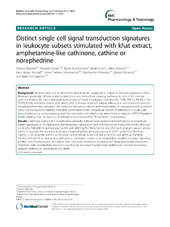Distinct single cell signal transduction signatures in leukocyte subsets stimulated with khat extract, amphetamine-like cathinone, cathine or norephedrine
Bredholt, Therese; Ersvær, Elisabeth; Erikstein, Bjarte Skoe; Sulen, André; Reikvam, Håkon; Aarstad, Hans Jørgen; Johannessen, Anne Christine; Vintermyr, Olav Karsten; Bruserud, Øystein; Gjertsen, Bjørn Tore
Peer reviewed, Journal article
Published version

Permanent lenke
https://hdl.handle.net/1956/7869Utgivelsesdato
2013-07-11Metadata
Vis full innførselSamlinger
Originalversjon
https://doi.org/10.1186/2050-6511-14-35Sammendrag
Background: Amphetamine and amphetamine derivatives are suggested to induce an immunosuppressive effect. However, knowledge of how amphetamines modulate intracellular signaling pathways in cells of the immune system is limited. We have studied phosphorylation of signal transduction proteins (Akt, CREB, ERK1/2, NF-κB, c-Cbl, STAT1/3/5/6) and stress sensors (p38 MAPK, p53) in human leukocyte subsets following in vitro treatment with the natural amphetamine cathinone, the cathinone derivatives cathine and norephedrine, in comparison with a defined extract of the psychostimulating herb khat (Catha edulis Forsk.). Intracellular protein modifications in single cells were studied using immunostaining and flow cytometry, cell viability was determined by Annexin V-FITC/Propidium Iodide staining, and T-lymphocyte proliferation was measured by 3H-thymidine incorporation. Results: Cathinone, cathine and norephedrine generally reduced post-translational modifications of intracellular signal transducers in T-lymphocytes, B-lymphocytes, natural killer cells and monocytes, most prominently affecting c-Cbl (pTyr700), ERK1/2 (p-Thr202/p-Tyr204), p38 MAPK (p-Thr180/p-Tyr182) and p53 (both total p53 protein and p- Ser15). In contrast, the botanical khat-extract induced protein phosphorylation of STAT1 (p-Tyr701), STAT6 (p- Tyr641), c-Cbl (pTyr700), ERK1/2 (p-Thr202/p-Tyr204), NF-κB (p-Ser529), Akt (p-Ser473), p38 MAPK (p-Thr180/p- Tyr182), p53 (Ser15) as well as total p53 protein. Cathinone, cathine and norephedrine resulted in unique signaling profiles, with B-lymphocytes and natural killer cells more responsive compared to T-lymphocytes and monocytes. Treatment with norephedrine resulted in significantly increased T-lymphocyte proliferation, whereas khat-extract reduced proliferation and induced cell death. Conclusions: Single-cell signal transduction analyses of leukocytes distinctively discriminated between stimulation with cathinone and the structurally similar derivatives cathine and norephedrine. Cathinone, cathine and norephedrine reduced phosphorylation of c-Cbl, ERK1/2, p38 MAPK and p53(Ser15), and norephedrine induced Tlymphocyte proliferation. Khat-extract induced protein phosphorylation of signal transducers, p38 MAPK and p53, followed by reduced cell proliferation and cell death. This study suggests that protein modification-specific singlecell analysis of immune cells could unravel pharmacologic effects of amphetamines and amphetamine-like agents, and further could represent a valuable tool in elucidation of mechanism(s) of action of complex botanical extracts.
Utgiver
BioMed CentralTidsskrift
BMC Pharmacology and ToxicologyOpphavsrett
Copyright 2013 Bredholt et al.; licensee BioMed Central Ltd.Therese Bredholt et al.; licensee BioMed Central Ltd.
